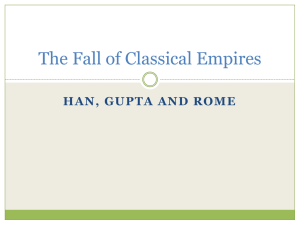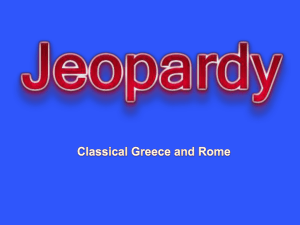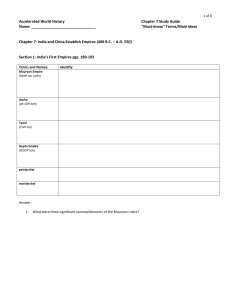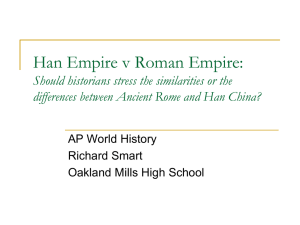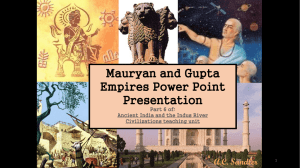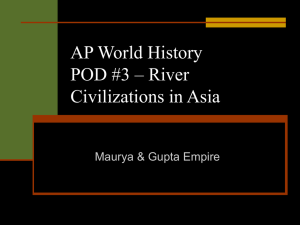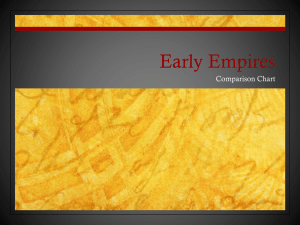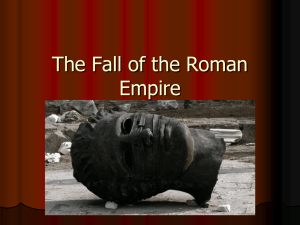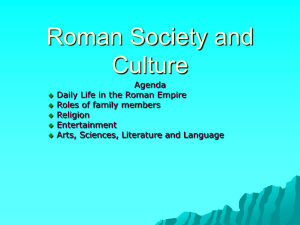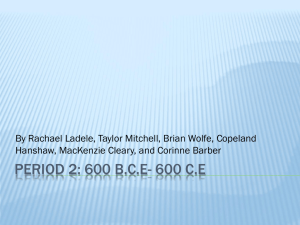Unit2-20Questions
advertisement
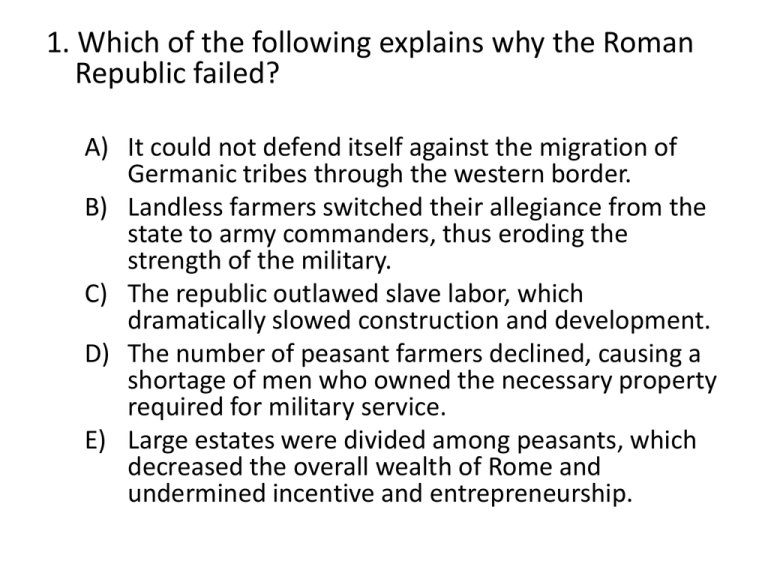
1. Which of the following explains why the Roman Republic failed? A) It could not defend itself against the migration of Germanic tribes through the western border. B) Landless farmers switched their allegiance from the state to army commanders, thus eroding the strength of the military. C) The republic outlawed slave labor, which dramatically slowed construction and development. D) The number of peasant farmers declined, causing a shortage of men who owned the necessary property required for military service. E) Large estates were divided among peasants, which decreased the overall wealth of Rome and undermined incentive and entrepreneurship. Answer: B 2. Which Chinese dynasty is represented in the map above? A) B) C) D) E) Shang Zhou Qin Han Song Answer: D 3. All of the following are characteristics of the Mandate of Heaven EXCEPT: A) The monarch was considered the “Son of Heaven”. B) Rulers were expected to govern as wise and principled guardians of the people. C) Corruption, violence, and arrogance were viewed as signs of divine displeasure. D) Failure to abide by Confucian tenets legitimized changes in monarchs. E) The Mandate of Heaven was the basis of the dynastic cycle that lasted thousands of years. Answer: C 4. All of the following are true of the Greek citystates of Athens and Sparta EXCEPT: A) Sparta banned coins and commerce in an effort to maintain equality among its citizens. B) The Spartan army was superior to all on land, while the Athenian navy could not be challenged at sea. C) Spartan foreign policy was cautious and isolationist, and it tried to maintain peace through a system of alliances with its neighbors. D) Athens implemented a limited democracy in which upper classes participated in an assembly. E) Athens and Sparta battled each other for survival during the Peloponnesian War. Answer: D 5. The society of the Persian Empire: A) B) C) D) E) Lacked a clear social structure. Extended equal rights to women. Was patriarchal in nature. Placed little value on warriors and the military. Was centralized and homogeneous. Answer: C 6) All of the following are similarities between Christianity and Buddhism EXCEPT: A) Both arose as a response to existing belief systems. B) Both were founded by an individual and based on his teachings. C) Followers of both religions went through periods of persecution and oppression. D) Both are based on a set of beliefs and actions that guide one’s life. E) Early practitioners of both religions placed importance on the existence of a god. Answer: E 7. Before 800 B.C.E. Indo-European steppe tribes were different from Chinese, Indian and Middle Eastern societies in which of the following ways? A) Steppe societies were more likely to have built architectural monuments with religious symbolism. B) Indo-European societies were ruled by oligarchies, while the other societies were governed by monarchies. C) Indo-European tribes did not develop a common religion on which to base social bonds. D) Chinese, Indian, and Middle Eastern societies formed permanent settlements with wealth based on land. E) Chinese, Indian, and Middle Eastern societies were more concerned with expansionism than the Indo-Europeans. Answer: D 8. Which of the following is NOT an accurate statement about Confucianism? A) The ethical system is primarily concerned with relationships. B) Specific duties are tied to one’s status in society. C) It prescribes the correct organization of the state to achieve the maximum benefits for the most members of society. D) People are basically good and evil arises as a result of improper education. E) Only those who are devout and lead moral lives will be saved. Answer: E 9. Which of these was NOT an outcome of the Bronze Age? A) B) C) D) E) Increased agricultural efficiency The rise of an aristocratic military class. The fall of centralized governments Increased contact among different cultures Additional outlets for artistic expression Answer: C 10. In comparing the Han Dynasty with the Roman Empire, which of the following statements is NOT correct? A) Both the Han Dynasty’s and Roman Empire’s economies suffered as a result of military spending. B) While Rome was successful at spreading its culture across a wide area, the Han were unable to diffuse their culture to neighboring lands. C) While both societies were run by centralized governments, Rome gave significant autonomy to local officials. D) While the Chinese were able to re-establish their imperial empire, Rome was never restored to its former status. E) A by-product of military expansion in both societies was cultural diffusion and increased trade. Answer: B 11. African goods traded on the Trans-Saharan Route included: A) B) C) D) E) Tea and cloth Silver and gold Salt and gold Silk and salt Spices and salt Answer: C 12. Roman law was unique in which of the following ways? A) It was the first set of laws written down for easy transmission. B) It was arranged systematically for easy reference. C) It was a combination of Roman law and foreign law. D) It extended freedom of religions to everyone in the empire. E) It codified the rights of slaves, servants and those accused of crimes. Answer: E 13. The foundation of ancient Indian civilization is best described by all of the following EXCEPT: A) B) C) D) E) Reincarnation. The Dao. Caste. Karma. Hinduism. Answer: B 14. How did the collapse of Han China resemble the Roman Empire’s loss of its European lands? A) Both were later devoured by the Byzantine Empire. B) Their leaders began to rely on astrology to guide their decision making. C) Both fell as a result of depletion of natural resources. D) Outside invaders contributed to the collapse of both empires. E) Both collapse due to lack of technological innovation. Answer: D 15. Which Asian religion was founded by Siddhartha Gautama? A) B) C) D) E) Confucianism Jainism Hinduism Eastern Orthodoxy Buddhism Answer: E 16. The Hindu concept of samsara is BEST described by which of the following statements? A) A belief that the wicked are punished by everlasting torment after death. B) A belief that one’s soul lives, dies, and is reborn many times, until it is pure enough to escape the cycle of rebirth. C) A doctrine that justifies the caste system of India. D) A declaration of non-belief in the old Vedic gods and goddesses. E) A belief that all actions good and evil, have consequences in future lives to come. Answer: B 17. Which of the following BEST encapsulates Confucian thought? A) Political power is given to rulers by the gods; therefore, rulers may treat their people as they please. B) Husbands and wives should share the responsibility for family leadership equally. C) Social harmony is attained when superiors treat those below them with kindness, while inferiors respect those above them. D) Only members of the aristocracy are capable of cultivating the qualities of etiquette and grace. E) Society functions best when people are free to realize their individuality. Answer: C 18. Greek hoplites and Roman legions share each of the following characteristics EXCEPT: A) B) C) D) They both were indicative of Bronze Age technology. They featured organizational patterns of rows of men in succession. They carried spears and short swords for close-contact fighting. They were led by seasoned commanders who had seen the most battle experience. • Answer: A 19. Which of the following was NOT a characteristic of the rise to power and influence of Southeast Asian entrepots like Funan? • A. Their positioning in the middle seas between China and India took advantage of heavy trade. • B. They taxed and placed duties on incoming goods, merchant services, and supplies. • C. They developed centralized political networks that created some of Asia’s first empires. • D. They facilitated communication and cultural contact, thus ushering in a heterogeneous mix of population. • Answer: C 20. Which of the following demonstrates a major difference between the Mauryan and Gupta empires in India? • A. Mauryan political power stemmed from its capital city at Pataliputra, while the Gupta were centered more south in the Tamil kingdoms. • B. The Mauryan conquered and maintained territory through a loyal, paid army, while the Gupta maintained ties to local leaders by establishing patterns of ceremony and gift-giving to the nobility. • C. The Mauryan championed traditional Vedic beliefs, while the Gupta was known for supporting the spread of Buddhism. • D. Trade was more important to the Mauryan Empire than it was for the Gupta. • Answer: B

